Connecting the Tour de France - more complicated than it sounds
With the Tour de France in full flow, Orange gave Telecoms.com a behind-the-scenes tour to show how complicated it is to deliver connectivity for such an event.
July 17, 2017

With the Tour de France in full flow, Orange gave Telecoms.com a behind-the-scenes tour to show how complicated it is to deliver connectivity for such an event.
As one of the technical partners for the tour, Orange has been tasked with ensuring connectivity, for both consumers and broadcasters, meets the high demands which we hold in the digital economy. And if it looks simple when you’re watching it on TV, its anything but when you get buried beneath the cables and frenzied activity, in the 30 degrees heat, while surrounded by a couple of thousand boozed up punters in lycra.
Looking at the numbers, you start to get a feel for the challenge. The tour takes place over 21 days, covering 3,535 km, entering four different countries, as well as 35 regions in France. Each stage is broadcast 190 countries around the world, on 100 different channels (60 of which are live), which equates to 80 hours of live coverage and a total of 6,300 hours of air-time in total.
And it’s quite a spectacle. We had the opportunity to drive the entire route ahead of the cyclists (the driving was actually done by our charming guide, former professional cyclist and three-stage winner on the Tour De France, Charly Mottet), and while the scenery was lovely, it was hardly the most friendly environment for delivering connectivity.
And when you get into the technical area at the finish line, the complications are compounded into an area about the same size as a football pitch (or at least the one which we visited). The Orange technical vans are a permanent fixture in the middle, but the additional 120 trucks from the broadcasters or the 20 km of fibre optic cables or the 65 km of power cables change every day.
There are also roughly 750 temporary 5G antennas (provided by Huawei and Ericsson) scattered throughout the country, as well as 26 relay vehicles to reinforce the mobile network coverage. Eight WiFi networks are deployed in each of the villages, as well as 24-hour video surveillance. Suddenly providing connectivity for such an event becomes a bit more complicated.
“It’s an absolute circus,” said Henri Terreaux, Director of Orange Events technical teams. “Every day is something completely different.”
Terreaux, who is now on his 20th Tour De France, oversees all the connectivity activities, including the 40 permanent members of Orange staff, and the 20 additional bodies which are provided at each stage. Terreaux’s job is essentially to make connectivity is an afterthought and ensure the content is delivered to broadcasters seamlessly. In other words, he’s the guy who makes everything work.
But what makes the tour so complicated and unique is the scale and breadth of the event. Terreaux has overseen scores of other events, including the UEFA European Championships and G20, but these are simple in comparison; they don’t move. You can build in the fibre cables, test them out in the weeks building up to the event and then sit back cosily when the event is running.
But try laying cable along 3,535 km of road, which runs through national parks, farmers’ fields, up to altitudes of 2,642 metres and through heavily populated cities. And it’s not even like it could be considered a long-term investment as the route changes every year. You also have to set up 21 different technical areas for the broadcasters and 21 press centres, which could be a few kilometres away.
The way around this challenge is quite a clever one. The images themselves are captured using six cameras (which seems very efficient), four of which are on motorbikes and two are on helicopters. The images themselves are sent from the cameras, using a 4.5G dongle, to hovering helicopters, which relay the signal up to circling planes. From the planes, the images are sent to a very large crane in the technical area, which runs a pretty substantial fibre cable into the Orange vans. This is where the 20 km of fibre cables takes over as the content is distributed to the various broadcasters.
Walking around the technical area is a tricky task considering the number of cables snaking everywhere, but amazingly Terreaux doesn’t know the lay of the land until he arrives each morning. Although it seems baffling that spaces are not assigned to each of the broadcasters, it sounds like at the end of each day another race begins between the broadcasters, scrambling to the next stages finish line, before scrapping for the best spot.
And Terreaux is left to clean up all the chaos at the finishing line. Break down begins at 4pm where all the cables are collected, and transported to the next stages at 11pm. Set up at the next stage begins at 5am, and this is when Terreaux finds out who has set up where, and what route the cables need to take. There’s not a lot of wiggle room as broadcasting needs to begin at 10am, but Terreaux seemed to be happier in the chaos than the quiet.
So it’s a complicated job, but we’re certainly glad someone else is doing it. As you can see from the video below, we were a lot happier sat at the finish line with a glass of champagne (which you were clearly drinking while you shot the footage – Ed).
If you scroll down, there’s also a little recap of the entire trip.
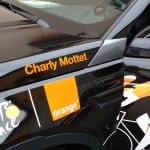 Ex pro cyclist and three stage winner at the Tour De France, Charley Moffet, was our guide for the day
Ex pro cyclist and three stage winner at the Tour De France, Charley Moffet, was our guide for the day
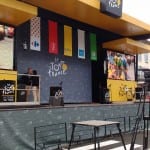 Television stage at the starting village
Television stage at the starting village
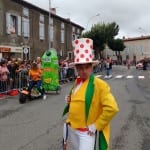 Not too sure what was going on here
Not too sure what was going on here
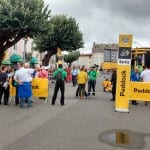 Starting line prior to the chaos
Starting line prior to the chaos 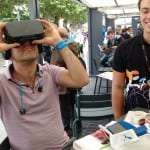 CCS Insight’s Paolo Pescatore getting on with a bit of cycling VR
CCS Insight’s Paolo Pescatore getting on with a bit of cycling VR 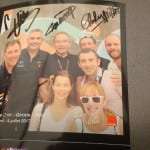 Cheeky snap with four ex-pro cyclists
Cheeky snap with four ex-pro cyclists
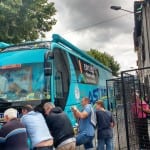 Team bus of Yellow Jersey holder (at the time) Fabio Aru
Team bus of Yellow Jersey holder (at the time) Fabio Aru 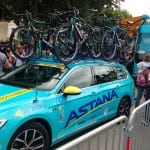 Number of bikes per team was staggering
Number of bikes per team was staggering 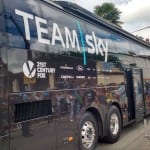
 GO TEAM SKY
GO TEAM SKY 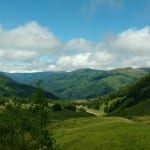 Not a bad view from the top of the mountain
Not a bad view from the top of the mountain 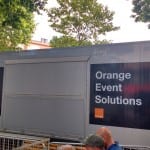 One of the three Orange buses in the technical area
One of the three Orange buses in the technical area
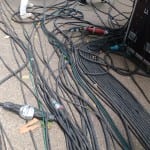 Definitely had to watch where you were stepping
Definitely had to watch where you were stepping 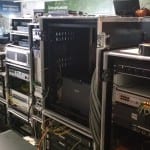 It didn’t seem like a huge amount of hardware to run the event
It didn’t seem like a huge amount of hardware to run the event 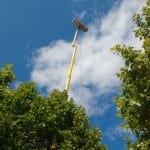 The crane above the technical area which collected all the transmissions from the race
The crane above the technical area which collected all the transmissions from the race
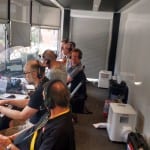 The commentary box
The commentary box  Henri Terreaux, Director of Orange Events technical teams
Henri Terreaux, Director of Orange Events technical teams
About the Author
You May Also Like


.png?width=300&auto=webp&quality=80&disable=upscale)







.png?width=300&auto=webp&quality=80&disable=upscale)


_1.jpg?width=300&auto=webp&quality=80&disable=upscale)